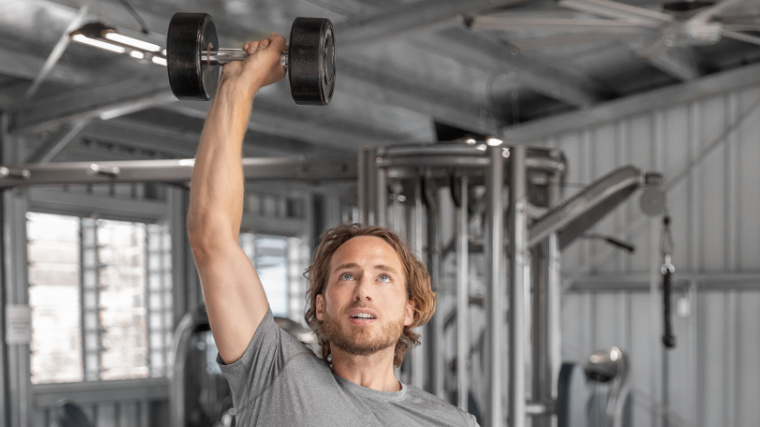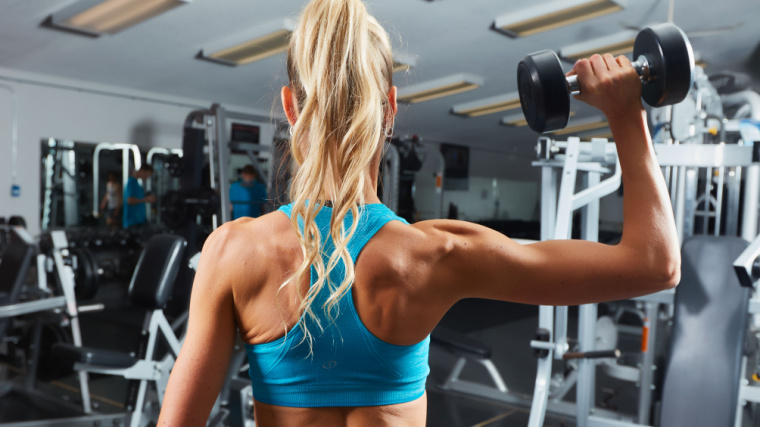If you think about it, almost all dumbbell exercises are performed simultaneously. You curl with both arms at a time. When you grab a pair of ‘bells to bang out a few sets of lateral raises, you move your arms in sync.
While this is certainly smart and saves time, working your limbs in tandem also eliminates one of the key benefits of dumbbell-based workouts. If you want to add some spice to your next shoulder workout and truly capitalize on all that dumbbells have to offer, you might want to add in the alternating dumbbell press.

If you’ve done any overhead press variation in the past, the alternating press shouldn’t be unfamiliar territory to you. However, you probably aren’t that attuned to doing a compound exercise in sequential fashion. Here’s what you stand to gain from the alternating dumbbell press. Hint: It’s much more than stronger shoulders.
- How To Do the Alternating Dumbbell Press
- Alternating Dumbbell Press Variations
- Alternating Dumbbell Press Alternatives
- Who Should Do the Alternating Dumbbell Press
- Alternating Dumbbell Press Sets and Reps
- Benefits of the Alternating Dumbbell Press
- Muscles Worked by the Alternating Dumbbell Press
- Common Alternating Dumbbell Press Mistakes
- Frequently Asked Questions
How To Do the Alternating Dumbbell Press
The most important aspect of the alternating dumbbell press is in the name; you need to press with one arm at a time, rather than press both dumbbells up at the same time.
[Read More: 5 At-Home Workouts for Strength, Muscle Growth, Power, and More]
You can perform the alternating dumbbell press seated or standing. That said, it’s probably easier to do so seated, at least at the beginning until you acclimate to the increased stability demands of the movement.
- Step 1 — Take a seat on a low bench with back support. Rest a pair of dumbbells on each of your knees.
- Step 2 — One at a time, kick each dumbbell up to shoulder level. Your arms should be parallel to each other with your elbows pointing sideways and the dumbbells suspended beside your head.
- Step 3 — Press one arm up above your head at a time. Begin with your dominant arm, lower the weight back down, and then press the other weight up while holding the first arm motionless.
Alternating Dumbbell Press Variations
The alternating dumbbell press is, in and of itself, a variation on the standard dumbbell overhead press. That said, you can take the alternation aspect and capitalize on it through some similar exercises. Give these alternating dumbbell press variations a go:
Standing Alternating Dumbbell Press
[Read More: The Best Online Workout Programs For Coaching, Cardio, Value, And More]
- Stand upright with a wider-than-hip-width stance, holding a light-to-medium dumbbell in either hand.
- Perform a dumbbell clean to hoist the weights up to your shoulders. Hold the weights aloft beside your head.
- Brace your core, inhale, and then press one of the weights upward until your arm locks out.
- Lower the weight down, recycle your breath, and then press the opposing arm upward. Alternate and repeat.
Single-Arm Dumbbell Press
[Read More: The Best Full-Body Bodybuilding Workout for Beginner to Advanced Lifters]
- Grab a dumbbell and stand with a hip-width stance. Place the hand of your non-working arm on your hip, or hold that arm loosely out to the side for balance.
- Hoist or clean the dumbbell up to your shoulders and suspend it beside your head.
- Inhale, brace your core, and press the weight upward until your elbow locks out.
- Lower the weight back down, taking care to not shift your torso as you return the dumbbell to the starting position.
Alternating Dumbbell Press Alternatives
Try as you might, you may simply find the alternating dumbbell press too awkward to be worthwhile. But if you still want to reap the benefits of an alternating exercise, you can try out some of these alternatives instead:
Alternating Dumbbell Bench Press
[Read More: The Ultimate 10-Week Powerbuilding Workout Routine for Mass and Strength]
- Sit at the end of a flat weight bench with a pair of dumbbells resting on your knees.
- Brace your core and then kick off the ground with your legs, sitting back and lying down on the bench
- Suspend the dumbbells above you with both of your arms locked.
- Inhale and then unlock one of your arms to lower one dumbbell down to your chest.
- Press it back up, then unlock the other arm and perform the same action.
Military Press
[Read More: Get Freakishly Strong With the 5×5 Workout Program]
- Address a barbell that you’ve set up in a squat or power rack at around clavicle height.
- Grip the bar with a shoulder-width overhand grip and remove it from the rack.
- Take a closer-than-hip-width stance, ideally with your feet touching one another. Hold the bar in a front rack position.
- Inhale, tilt your head backward, and press the bar straight up over your head until your arms lock out.
Single-Arm Landmine Press
[Read More: What Are Workout Splits and Which Is the Best One?]
- Set a barbell into a landmine fixture, loaded with plates if you need extra weight.
- Stand about a foot away from the end of the bar. Then, hoist the end of the shaft up with your working arm.
- In the starting position, your upper arm should be parallel to your torso with your elbow tucked tightly to your side.
- Press the end of the barbell up and away from your body until your elbow locks out.
Who Should Do the Alternating Dumbbell Press
You don’t necessarily need a compelling, evidence-based reason to perform the alternating dumbbell press. If you’re a bit bored of your standard shoulder exercises, that’s more than enough of a reason to switch things up. But it’s hardly the only case for the movement.
Beginners
When you’re just starting out in the gym, one of the most important investments you can make into your health and performance is developing robust joint stability. Put simply, this means your ability to control both your body and external weights in space.

Standard overhead presses will certainly do the trick, but the alternating dumbbell press antes up on the stability demands. Holding one weight motionless while moving the other means the alternating shoulder press is both an isometric exercise and isotonic. It trains two different athletic qualities at once.
If You Need More Endurance
When it comes to dumbbell exercises for bodybuilding, general health, or any other purpose, working with both weights simultaneously is the most efficient option. Alternating which arm (or leg) moves will literally double the amount of time it takes to complete a set of whatever movement you’re doing.
On the upside, elongating the duration of your sets will demand more of your muscular and cardiovascular endurance. Your arms may take turns pressing, but they certainly aren’t at rest. Holding the dumbbell in the starting position takes energy, which improves postural endurance.
If You Have a Muscular Imbalance
Unilateral exercises are fantastic for identifying, and attacking, imbalances or discrepancies in strength, stability, or muscular size. They serve as both diagnostic and prescriptive tools. The field of exercise science is crystal-clear; most people should include at least a few single-limb movements in their strength training plan. (1)

As such, you can use the alternating dumbbell press to even out any issues between your shoulders. The alternation specifically allows you to test and compare your strength and flexibility between your shoulders in real time. For best results, you should begin with your non-dominant arm.
Alternatively, you can also perform all of your prescribed repetitions with that arm before pressing with your stronger arm.
Alternating Dumbbell Press Sets and Reps
As a compound shoulder exercise, the alternating dumbbell press is surprisingly versatile. While its primary benefits are to your shoulder stability and endurance, you can certainly use the alternating press for a variety of other purposes:
- For Muscle Mass: Try 3 or 4 sets of 8 to 12 repetitions per arm.
- For Strength: Go for 3 to 5 sets of 5 to 8 repetitions per arm.
- Your First Time: Keep it simple with 3 sets of 10 repetitions in total, five per arm.
Benefits of the Alternating Dumbbell Press
The alternating dumbbell press is a one-stop shop: You can use it to develop a variety of different functional qualities at the same time. Here’s a short list of what you stand to gain.
Shoulder and Upper Back Strength
Any overhead pressing variation you perform will challenge the musculature that surrounds your shoulder joint and scapula. This includes your anterior, lateral, and posterior deltoids, as well as smaller muscles like the infraspinatus, teres major and minor. You even get some free triceps work by extending your elbow.

[Read More: The Best Back Workout for Men, Women, Strength, and More]
As such, the alternating dumbbell press is a phenomenal way to develop robust stability and strength in your shoulders. You also access more than one type of stimulation, as your muscles have to both contract to push the weight dynamically and stabilize the dumbbell motionless in space.
More Time Under Tension
By pressing each weight individually rather than using both arms at the same time, the alternating dumbbell press creates more time under tension. More mechanical tension is highly conducive to creating hypertrophy, (2) or muscle growth.
Extra time under tension also increases your efficiency in the gym. Two long, challenging sets of alternating shoulder presses could be just as effective as three or four sets of presses with a barbell.
Improves Coordination
All unilateral exercises improve bodily coordination to some degree. That said, alternating your repetitions on the shoulder press will challenge you even more. Pressing a pair of dumbbells up at the same time is more intricate than pressing a barbell, but holding one dumbbell aloft while pressing another is harder still.
Muscles Worked by the Alternating Dumbbell Press
Any overhead press you perform will work the same muscles; your shoulders, triceps, and portions of your upper back. But alternating your reps will challenge your core to a greater degree than you’d get from a bilateral or two-armed press.
Deltoids
Your deltoids are comprised of three different sections. The front part of your shoulder, housing your anterior deltoid, takes the brunt of the load during any pressing movement. Its function is to flex, or raise, your upper arm in space.
Triceps
Pressing movements are compound exercises, which mean they involve motion and load at more than one joint at a time. Any press requires you to extend your elbow — a duty that falls solely upon your triceps brachii.
Upper Back
Shoulder presses aren’t necessarily upper back exercises. But, since pressing involves rotating your scapula, the musculature bound to your shoulder blade is called into action to stabilize and facilitate that movement.
As such, exercises like the alternating dumbbell press are great for strengthening your upper back muscles and improving their functionality, even though pressing won’t help you grow your trapezius, rhomboids, or lats.
Core
The alternation aspect of the press challenges your core to a greater degree than you’d experience if you used other equipment like a barbell.

[Read More: 5 Bench Press Programs to Build a Bigger, Stronger Chest]
While the weight is evenly distributed across your body from left to right, moving one dumbbell while stabilizing another demands more from postural muscles like your rectus abdominis, external obliques, and transverse abdominis.
Common Alternating Dumbbell Press Mistakes
There are a host of potential mistakes lying in wait during the alternating dumbbell press. Steer clear of these common errors if you want to maximize your performance.
Moving Your Other Arm
The hallmark of the alternating dumbbell press is holding one weight steady while working the other arm. If your non-working arm flutters or falters, you’re defeating the purpose.
The alternating dumbbell press takes both mental and physical effort. When you’re pressing one dumbbell up, take care to not get lazy and allow your “resting” arm to drift or sag downward.
Going Too Heavy
You will not be able to push as much weight with the alternating dumbbell press as you would during a standard overhead press, even if you typically prefer to work with dumbbells during your shoulder workouts.

Holding one weight motionless for a few seconds at a time, repeatedly, saps you of energy. This increases the efficiency of the exercise, allowing you to accumulate more fatigue with lighter weights. However, you shouldn’t expect to be able to lift ultra-heavy at the same time.
Forgetting To Breathe
Proper breathing and bracing habits are integral to good performance in the weight room, no matter what equipment you’re working with. When you’re performing the alternating dumbbell press, don’t let the intricacy of the movement detract from proper breathing. Inhale as you lower one arm down, exhale as you press the other up.
FAQs
The alternating dumbbell press has a lot going for it, but it can also be a bit confusing. Here are some common questions — and answers.
Is the alternating dumbbell press better than the regular dumbbell press?
It’s hard to argue that one exercise is strictly better or worse than another. Mostly, it depends on context. If you’re training specifically for endurance or joint stability, the alternating dumbbell press may be a more effective tool for your goals.
When should I do the alternating dumbbell press?
You can perform the alternating dumbbell press for a number of reasons. The novelty is more than good enough to give it a go, but you may also want to try it out if you need to work on your bodily coordination.
Which arm do I start with on the alternating dumbbell press?
You’re only as strong as your weakest link. Unilateral exercises are great for balancing your body, but can also worsen discrepancies in strength if you emphasize your strong arm and neglect your weaker one. To avoid this issue, begin your sets of alternating presses with your non-dominant arm.
References
- Carroll, T. J., Herbert, R. D., Munn, J., Lee, M., & Gandevia, S. C. (2006). Contralateral effects of unilateral strength training: evidence and possible mechanisms. Journal of applied physiology (Bethesda, Md. : 1985), 101(5), 1514–1522.
- Schoenfeld BJ. The mechanisms of muscle hypertrophy and their application to resistance training. J Strength Cond Res. 2010 Oct;24(10):2857-72. doi: 10.1519/JSC.0b013e3181e840f3. PMID: 20847704.
Featured Image: Maridav / Shutterstock
The post How To Do the Alternating Dumbbell Press (+ the Best Variations for Muscle and Strength) appeared first on BarBend.
